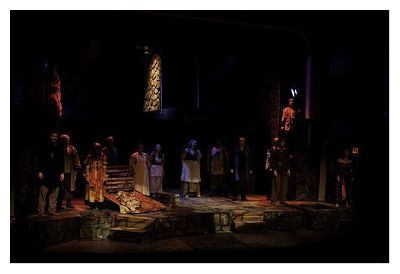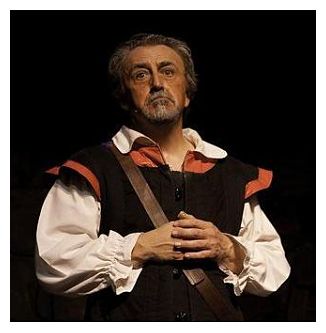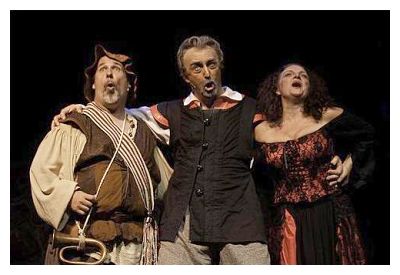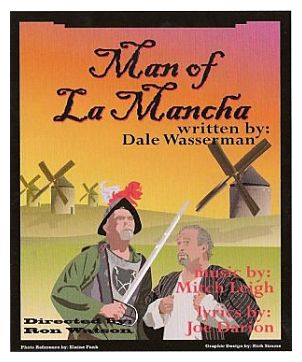Review: Man of La Mancha by The Georgetown Palace Theatre
by Michael Meigs
The Georgetown Palace production of Man of La Manchastarts out moody, atmospheric and harsh, and it comes surging beautifully through that dark, difficult second act.
The Inquisition is awaiting in the darkness above, and Cervantes is storytelling to save his life and possessions from the thieves and murderers who surround him. In Cervantes' fantastical tale of the deranged Alonso Quijana, the Knight of the Woeful Countenance has lost it. The knight's beloved Dulcinea--Aldonza the prostitute and scullery maid--has been gang raped, and he doesn't know it.
Dulcinea curses Quijana for his foolishness and his misguided belief that life contains any hope at all.
Then, in the filth and stink of the prison despite the misadventures of his quest, Joe Penrod as Cervantes/Quijana/Quijote replies with The Impossible Dream:
To dream the impossible dream;
To fight the unbeatable foe;
To bear with unbearable sorrow,
To run where the brave dare not go.
To right the unrightable wrong;
To be better far than you are;
To try when your arms are too weary
To reach the unreachable star . . . .
It's an exalting and inspired moment, one that squeezes the heart and puts into you the dizzy hope of beauty, meaning and peace.
I knew it was coming; I knew that Man of La Mancha is calculated to pull us out of our chairs and out of ourselves with that burst of light in the depths of a prison. But I couldn't help it; I felt the catch in my throat and the warm flow of emotion in my eyes.
Not enough to reach for a handkerchief or to embarrass myself by rubbing my eyes with the back of my hand, but still -- Penrod and the Palace caught me. Both then and at the death of the exhausted old knight.
But I'm getting ahead of myself.
Man of La Mancha is one of the most enduring pieces of the American musical theatre. The first New York production in 1965 received four Tony awards. By 1970 the show had been presented in twenty different productions abroad. Man of La Mancha has been revived four times on Broadway, most recently in 2002.
It actually started out as a television drama, written by Dale Wasserman for the Dupont Show of the Month on CBS, telecast in November, 1959 and starring Lee J. Cobb, Colleen Dewhurst and Eli Wallach. The version with music by Mitch Leigh and lyrics by Joe Darion opened at the Goodspeed Opera House in Connecticut in 1964.

Wasserman situates the play in a dungeon-like prison. Cervantes and his manservant Sancho are delivered there with their possessions because as a tax-collector on commission he delivered a writ of seizure for non-payment to an ecclesiastical institute connected with the Inquisition. The other prisoners, thieves and murderers all, constitute a court to "try" the new arrivals and seize their goods. Cervantes asks to defend himself by acting out a story --which is, of course, that of Alonso Quijana and his harebrained quest as the imaginary Don Quijote.
Man of La Mancha  uses famous incidents from the opening of Cervantes' novel -- principally from the first eight of the total of 126 chapters in the two voluminous parts of Don Quijote de la Mancha. Even so, the play is faithful to the spirit of the book and to the circumstances of its composition. Miguel de Cervantes did begin his novel in jail. The editors of the definitive Aguilar edition published in Madrid describe it:
uses famous incidents from the opening of Cervantes' novel -- principally from the first eight of the total of 126 chapters in the two voluminous parts of Don Quijote de la Mancha. Even so, the play is faithful to the spirit of the book and to the circumstances of its composition. Miguel de Cervantes did begin his novel in jail. The editors of the definitive Aguilar edition published in Madrid describe it:
The Prison Where the "Quijote" Was Conceived
From the colorful Sevilla milieu of poets and rascals, a disgraced and impoverished Cervantes] entered the Royal Prison of Sevilla in 1602 because he had not kept proper records for some of the many accounts that he had sought to collect for commissions and bonuses. The Sevilla prison was the most picturesque and frightening locale of that colorful time in Spain. Mixing freely behind its walls were repugnant criminals and persons such as Cervantes, whose unhappy stars had brought them to that filthy Tower of Babel. The numbers of prisoners were beyond counting and the disputes among them were interminable. Some gambled at tables where they paid for the privilege. Four taverns within the prison served food and drink, and drunken singing mixed with the lamentations of those condemned to death. That was the setting for Cervantes as he wrote, seeking to scare away his own dark thoughts, perhaps in order to prepare a text with which to earn some meager resources when he got out of that hell, "where all sorts of discomfort have their seats and where every sad noise makes its dwelling.
Wasserman captures that violence, brutality and darkness.

The structure of the play also subtly mimics that of the great novel. Joe Penrod is playing Cervantes the downfallen aristocrat who presents a play in which he's Alonso Quijana, who thinks that he is don Quijote, a figure out of ancient tales of chivalry. The Georgetown Palace cast plays prisoners who assume roles in the story but drop out from time to time for their own purposes. These multiple levels exist in the novel, as well -- not only in the antic characters of the story but also in the changing person of the unidentified narrator, who opens the book with the sentence, "In a place in La Mancha, the name of which I do not wish to recall, not long ago there lived a nobleman of the class with a jousting lance, an ancient leather shield, a bony old horse and a greyhound running alongside."
The music is dramatic, the lyrics are by turns sharp, poignant, and funny. Director Ron Watson has four strong and vivid voices on which to build this clever plot. Joe Penrod is already a larger-than-life personality, and it's a pleasure to watch him plunge into the theatricality of Cervantes -- dabbing white face paint onto brows and mustache, ruffling his hair into a crazed nest, and singing both with precision and with abandon. His Cervantes plays his Quijana/Quijote as a bit of a doddering clown, an entirely acceptable interpretation even though I imagine the good knight rather as serene, determined and almost hallucinating.
Opposite him is the vivid and dynamic Cathie Sheridan as Aldonza/Dulcinea. Many another production of this show gives the audience a sylph-like Aldonza, vulnerable and girlish; Sheridan's Aldonza is sharp, vindictive and angry, fully a woman and fully in despair until Quijote's innocence awakens the child within her.

Dale Schultz, as the prisoner-elected "governor" who obliges Qujana by playing the Innkeeper, is solid and melodious, cynical at first but ultimately affable, and Justin Langford as the red-haired padre is somber, with a tenor voice of serene, heavenly note.
Scott Saunders gives us a Sancho Panza who is droll, appealing and loyal. He's making a semi-career of the role, having played it earlier at the Sam Bass Theatre, according to the program notes. One has the feeling that he has a twinkle in those eyes that he must guilelessly suppress.
The program doesn't give explicit credit for the design that massive, impressive set, although more than twenty names are listed for the building of it. A helpful inside source told me that Michael Davis and Ron Watson did the plans. As always, scenic artists Barb Jernigan and Sue Williams show themselves gifted, creative, and meticulous.
The Palace excels at moving big casts around its big sets with grace in dance and movement. Credit goes to Jessica Kelpsch for choreography and to Watson for the vigorous blocking. The hidden musicians are dexterous but for some reason musical director Jonathan Borden's keyboard has the odd sound of a Wurlitzer organ, quite inappropriate to the setting and the subject matter.
On opening weekend, lighting design and execution by Faith Castaneda were disasters. This show begs for a spotlight for its big numbers, but the company ran the show without one. During the overture, the house and stage were pitch dark and lights were intended to come up briefly, in succession, on each of three corners of the set to give us a sense of the miserable prisoners huddled there. The idea was a good one, but illumination was in each case insufficient and too brief for the audience to perceive anything at all.
One of the multiple-choice questions in Drama 101 is What is the primary function of stage lighting? and the correct answer is To make the actors visible to the audience. A corollary might be that lights should not draw attention to themselves. Too often during this show lights came up or shifted too suddenly or distracted our attention to areas with no action. Stage lights with red and blue gels were distractingly visible at the top and the sides of the stage, and the design relied too often on a blue or red wash to suggest atmosphere. And too often there was simply not adequate illumination for the actors' faces. Many of these problems will have been worked out by the time that you attend Man of La Mancha, which runs for another four weekends.
[photos courtesy of Georgetown Place Theatre, taken by Elaine Funk]
Review by Veronica Prior at Ronnisrants.blogspot.com, October 18
EXTRA
Click to view excerpts from the program for Man of La Mancha by the Georgetown Palace Theatre
Hits as of 2015 03 01: 11,966
Man of La Mancha
by Dale Wasserman, Mitch Leigh, Joe Darion
Georgetown Palace Theatre
